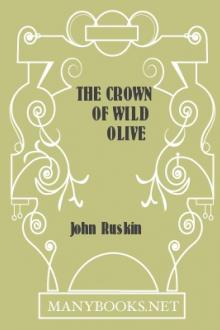The Queen of the Air, John Ruskin [classic novels for teens .TXT] 📗

- Author: John Ruskin
Book online «The Queen of the Air, John Ruskin [classic novels for teens .TXT] 📗». Author John Ruskin
And it is among the most notable indications of the volition of the animating power that we find the ethical signs of good and evil set on these also, as well as upon animals; the venom of the serpent, and in some respects its image also, being associated even with the passionless growth of the leaf out of the ground; while the distinctions of species seem appointed with more definite ethical address to the intelligence of man as their material products become more useful to him.
I can easily show this, and, at the same time, make clear the relation to other plants of the flowers which especially belong to Athena, by examining the natural myths in the groups of the plants which would be used at any country dinner, over which Athena would, in her simplest household authority, cheerfully rule here in England. Suppose Horace's favorite dish of beans, with the bacon; potatoes; some savory stuffing of onions and herbs, with the meat; celery, and a radish or two, with the cheese; nuts and apples for desert, and brown bread. The beans are, from earliest time, the most important and interesting of the seeds of the great tribe of plants from which came the Latin and French name for all kitchen vegetables,--things that are gathered with the hand--podded seeds that cannot be reaped, or beaten, or shaken down, but must be gathered green. "Leguminous" plants, all of them having flowers like butterflies, seeds in (frequently pendent) pods, --"lætum siliqua quassante legumen"--smooth and tender leaves, divided into many minor ones; strange adjuncts of tendril, for climbing (and sometimes of thorn); exquisitely sweet, yet pure scents of blossom, and almost always harmless, if not serviceable seeds. It is of all tribes of plants the most definite, its blossoms being entirely limited in their parts, and not passing into other forms. It is also the most usefully extended in range and scale; familiar in the height of the forest-- acacia, laburnum, Judas-tree; familiar in the sown field--bean and vetch and pea; familiar in the pasture--in every form of clustered clover and sweet trefoil tracery; the most entirely serviceable and human of all orders of plants. Next, in the potato, we have the scarcely innocent underground stem of one of a tribe set aside for evil; having the deadly nightshade for its queen, and including the henbane, the witch's mandrake, and the worst natural curse of modern civilization--tobacco.* And the strange thing about this tribe is, that though thus set aside for evil, they are not a group distinctly separate from those that are happier in function. There is nothing in other tribes of plants like the form of the bean blossom; but there is another family of forms and structure closely connected with this venomous one. Examine the purple and yellow bloom of the common hedge nightshade; you will find it constructed exactly like some of the forms of the cyclamen; and, getting this clue, you will find at last the whole poisonous and terrible group to be--sisters of the primulas!* It is not easy to estimate the demoralizing effect on the youth of Europe of the cigar, in enabling them to pass their time happily in idleness.
The nightshades are, in fact, primroses with a curse upon them; and a sign set in their petals, by which the deadly and condemned flowers may always be known from the innocent ones,--that the stamens of the nightshades are between the lobes, and of the primulas, opposite the lobes, of the corolla.
Next, side by side, in the celery and radish, you have the two great groups of unbelled and cruciferous plants; alike in conditions of rank among herbs: both flowering in clusters; but the unbelled group, flat, the crucifers, in spires: both of them mean and poor in the blossom, and losing what beauty they have by too close crowding; both of them having the most curious influence on human character in the temperate zones of the earth, from the days of the parsley crown, and hemlock drink, and mocked Euripidean chervil, until now; but chiefly among the northern nations, being especially plants that are of some humble beauty, and (the crucifers) of endless use, when they are chosen and cultivated; but that run to wild waste, and are the signs of neglected ground, in their rank or ragged leaves and meagre stalks, and pursed or podded seed clusters. Capable, even under cultivation, of no perfect beauty, thought reaching some subdued delightfulness in the lady's smock and the wallflower; for the most part they have every floral quality meanly, and in vain,--they are white without purity; golden, without preciousness; redundant, without richness; divided, without fineness; massive, without strength; and slender, without grace. Yet think over that useful vulgarity of theirs; and of the relations of German and English peasant character to its food of kraut and cabbage (as of Arab character to its food of palm-fruit), and you will begin to feel what purposes of the forming spirit are in these distinctions of species. Next we take the nuts and apples,--the nuts representing one of the groups of catkined trees, whose blossoms are only tufts and dust; and the other, the rose tribe, in which fruit and flower alike have been the types to the highest races of men, of all passionate temptation, or pure delight, from the coveting of Eve to the crowing of the Madonna, above the"Rosa sempiterna, Che si dilata, rigrada, e ridole Odor di lode al Sol."
We have no time now for these, we must go on to the humblest group of all, yet the most wonderful, that of the grass which has given us our bread; and from that we will go back to the herbs.
The vast family of plants which, under rain, make the earth green for man, and, under sunshine, give him bread, and, in their springing in the early year, mixed with their native flowers, have given us (far more than the new leaves of trees) the thought and word of "spring," divide themselves broadly into three great groups--the grasses, sedges, and rushes. The grasses are essentially a clothing for healthy and pure ground, watered by occasional rain, but in itself dry, and fit for all cultivated pasture and corn. They are distinctively plants with round and jointed stems, which have long green flexible leaves, and heads of seed, independently emerging from them. The sedges are essentially the clothing of waste and more or less poor or uncultivated soils, coarse in their structure, frequently triangular in stem--hence called "acute" by Virgil--and with their heads of seed not extricated from their leaves. Now, in both the sedges and grasses, the blossom has a common structure, though undeveloped in the sedges, but composed always of groups of double husks, which have mostly a spinous process in the centre, sometimes projecting into a long awn or beard; this central process being characteristic also of the ordinary leaves of mosses, as if a moss were a kind of ear of corn made permanently green on the ground, and with a new and distinct fructification. But the rushes differ wholly from the sedge and grass in their blossom structure. It is not a dual cluster, but a twice threefold one, so far separate from the grasses, and so closely connected with a higher order of plants, that I think you will find it convenient to group the rushes at once with that higher order, to which, if you will for the present let me give the general name of Drosidæ, or dew-plants, it will enable me to say what I have to say of them much more shortly and clearly. These Drosidæ, then, are plants delighting in interrupted moisture-- or at certain seasons--into dry ground. They are not among water-plants, but the signs of water resting among dry places. Many of the true water-plants have triple blossoms, with a small triple calyx holding them; in the Drosidæ the floral spirit passes into the calyx also, and the entire flower becomes a six-rayed star, bursting out of the stem laterally, as if it were the first of flowers and had made its way to the light by force through the unwilling green. They are often required to retain moisture or nourishment for the future blossom through long times of drought; and this they do in bulbs under ground, of which some become a rude and simple, but most wholesome, food for man. So, now, observe, you are to divide the whole family of the herbs of the field into three great groups,--Drosidæ, Carices,* Gramineæ,-- dew-plants, sedges, and grasses. Then the Drosidæ are divided into five great orders: lilies, asphodels, amaryllids, irids, and rushes. No tribes of flowers have had so great, so varied, or so healthy an influence on man as this great group of Drosidæ, depending, not so much on the whiteness of some of their blossoms, or the radiance of others, as on the strength and delicacy of the substance of their petals; enabling them to




Comments (0)